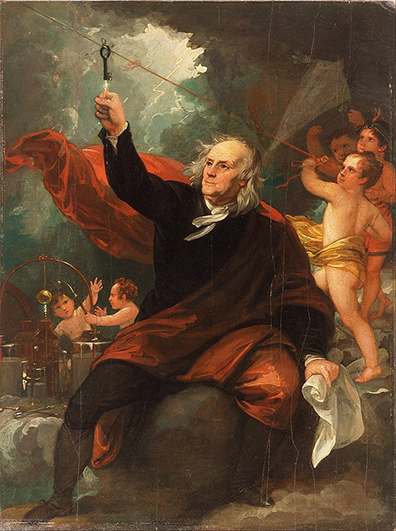 Do you know a myth from the truth? Marketing is sometimes
accused of misleading people into believing a myth about a brand.
Do you know a myth from the truth? Marketing is sometimes
accused of misleading people into believing a myth about a brand.
You’ve probably heard of Benjamin Franklin’s famous
experiment with electricity by flying a kite in a thunderstorm. In June 1752, Franklin
and his son, William, decided they would try to prove that lightning was
actually electricity. During a thunderstorm, Ben and William launched a kite
that had a small wire attached to it to attract lightning … a lightning rod of
sorts. He tied hemp string to the kite. Near the end of the string, he attached
a metal key that was attached with a wire to a Leyden jar. He then tied the
hemp string to a silk string. The hemp became wet when it started to rain, but
the silk remained dry because Franklin held it inside a barn. The idea was for
lightning to strike the kite, travel down the wet string to the key, which
would then fill the Leyden jar with electricity. The dry silk string would
resist the electrical charge and keep him and William safe. You have probably
heard that the kite was struck by lightning. The Franklins found the key
glowing in the light of the Leyden jar, where the high-powered charge was now
being stored.
How much of that story is true? Did Franklin actually
perform the experiment? It appears that he might have done so. Others were able to
replicate his results, although one unfortunate fellow was electrocuted about a
year later when lightning struck him. That leads to the part that is a myth:
lightning did not strike the kite. If it did, Ben and William would have been
fried. An average lightning bolt has around 300 million volts and 30,000 amps.
That is about 4,000 times the amps used in executing accused felons in an
electric chair. What happened was the wet string was electrically charged from
the atmosphere. The strands of the twine began to stand on end the way static
electricity makes our hair stand up. When Ben Franklin put his hand next to the
key, he got a spark that shocked him. He did not discover electricity, as some
have claimed, but he found that the atmospheric charges that caused lightning
also traveled up and down his kite string to the key.
Now you might ask, why in the wide world of sports did
someone as intelligent as Ben Franklin do something so stupid as to try to get
a lightning bolt to strike the kite he was holding? The answer is he had a
product to sell. Franklin was the inventor of the lightning rod. In order to
sell them, he needed a convincing piece of marketing that let people know that lightning
was electricity and electrical currents would be attracted to metal. Thus, if people
heard about his experiment, and believed it, he could sell them lightning rods
to save their homes and barns.
There are a lot of marketing methods that people claim
will work to help you sell your brand. I often get calls from clients after
they have talked to a sales rep who has tried to convince them that they should
be advertising with their particular medium. (One of my favorites was the
customer who said they were considering buying advertising space on shopping
carts in the grocery store. If that worked, wouldn’t the grocery store place
ads there?) Here is the truth about marketing: it works! It is essential to any
business selling its products and services. Here is also the truth: not every
marketing medium will work with your particular target market – the consumers
you are trying to turn into customers.
How do you know what will work and what will not? First,
know your customers very well. Study them and find out what mediums appeal to
them. Second, see what mediums can offer you real results in businesses similar
to yours. Just like a science experiment, good marketing should be replicated
to prove its hypothesis. If there are no tangible results from other businesses
in industries like yours, take a pass. Third, be skeptical of numbers that
sound too good to be true. Effective marketing methods never get 100%
participation. Effective marketing methods that get 1/3 participation are
really good. If someone is touting numbers above that, you are probably dealing
with a charlatan.
On the flip side, there are methods that will fit your
customers and get you good results. Make sure you measure your results and
compare your costs on marketing to what you are bringing in your door. Ben
Franklin did that. The written accounts of his kite experiment earned him the
attention of his target market. Dispel the myths and get to the essential
marketing.
______________________
Benjamin
Franklin Drawing Electricity from the Skypainting by
Benjamin West 1816